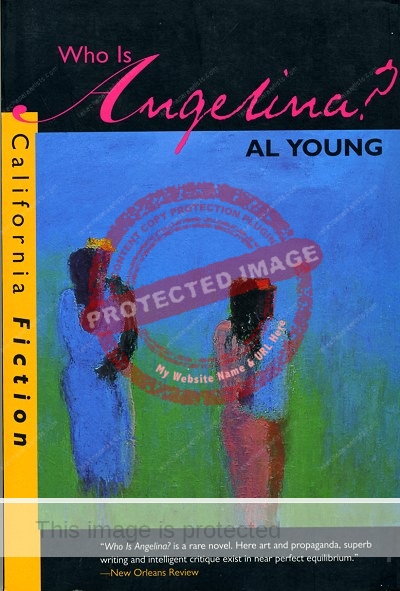A significant section of Al Young’s novel Who is Angelina?, first published in 1975, is set at Lake Chapala, where Young had spent some time in the mid- to late-1960s.
 The plot of Who is Angelina? is relatively simple. Angelina Green, an intelligent, 26-year-old, life-loving woman living in Berkeley, after the hippie phase, goes to Mexico to find herself. In Mexico City, she meets, and has an affair with, a tall, charismatic, enigmatic character named Watusi.
The plot of Who is Angelina? is relatively simple. Angelina Green, an intelligent, 26-year-old, life-loving woman living in Berkeley, after the hippie phase, goes to Mexico to find herself. In Mexico City, she meets, and has an affair with, a tall, charismatic, enigmatic character named Watusi.
They then house-sit in Ajijic for a while (for friends of Watusi) before Angelina receives news that her father has been attacked in his home, in Detroit, and is hospitalized.
Angelina races north and is forced to reexamine old family ties and friendships. After her father recovers, Angelina returns to California, takes up transcendental meditation and finds a job at an “alternate” school. Unexpectedly, Watusi shows up, but their connection has inevitably and irrevocably changed.
The novel was generally well-received, though Roberta Palm, in a review for Black World (September 1975), writes that “Young is as alienated from his character [Angelina] as she is described to be from herself and her peers.” She thought that Angelina remained “an ambiguous shadow in the novel”, despite Young’s “perfect ear for dialogue” and the fact that his characters spoke “with realistic tone and in genuine cadence.”
Young’s writing shows that he is a keen observer of life in Mexico, with a good ear for Mexican Spanish. Leaving Mexico City, the couple travel to Guadalajara by overnight train and stay in the Hotel Francés for a day or two before taking a bus to Chapala, and then a taxi to Ajijic. As Watusi observes, this is a time when, “Bebop done played out. Beatniks done played out … Bomb shit done played out. Psychedelic shit done played out. Bullshit revolution done played out. Hippies done played out and, look here, I’ll tell you somethin–nigger shit done just about played out too!”
In passing, the novel offers some insights into what Ajijic and Chapala were like in the 1960s. As Watusi and Angelina arrive in town, “All the Mexican passengers who’d ooo’ed an ahhh’d at the sight of water as the bus wound around Lake Chapala a little ways back were now scrambling to line up for the grand central get-off. One Indian woman was carrying a live chicken under one arm.” (81)
Once in Ajijic, Angelina asks Watusi if there are many hippies in the village. “Use to”, comes the reply, “but the Mexican government done just about shut the door for good on that jive. They tolerate the native hippies cause all of em come from upper-class families that’s got a lotta power and pull, but long-haired freaks from Gringoland got to straighten up when they step cross that border cause these crazy people down here don’t be playin! It used to be a gang of em layin out round here in Chapala and Ajijic but… the local people got to where they couldnt put up with they shit no longer and teamed up with the law and run they doped-up boodies clean out the state.” (86-87)
The room in which the couple share a joint and make love has a “quaint hip poster left over from the Mexico City Olympics” which “rounded out the homey effect”. (91) This is a reference to one of the series of posters designed for the Olympics Committee by Austrian artist Georg Rauch, whose studio was in Jocotepec.
Among the many footloose characters that Angelina and Watusi encounter at Lake Chapala are two stereotypical foreigners: an elderly English couple writing travel articles for British and American magazines, and an American girl in her late 20s, a former New York junkie who married a Mexican traveling salesman and is writing her memoirs. Another character they meet is a middle-aged freelance photographer who works in Guadalajara but lives in Chapala. (97)
While Who is Angelina? may not be Al Young’s greatest ever novel, it is still an interesting, enjoyable and thought-provoking read.
Book details: Who is Angelina? First edition: Holt, Rinehart and Winston, 1975. First paperback edition: University of California Press, 1996.
Other twentieth century novels set largely, or entirely, at Lake Chapala include:
- Charles Embree: A Dream of a Throne, the Story of a Mexican Revolt (1900)
- D. H. Lawrence: The Plumed Serpent (1926)
- Arthur Davison Ficke: Mrs. Morton of Mexico (1939)
- Ramón Rubín: La canoa perdida: Novela mestiza (1951)
- Ross MacDonald: The Zebra-Striped Hearse (1962)
- Eileen Bassing: Where’s Annie? (1963)
- Barbara Compton: To The Isthmus (1964)
- Willard Marsh: Week with No Friday (1965)
Sombrero Books welcomes comments, corrections or additional material related to any of the writers and artists featured in our series of mini-bios. Please use the comments feature at the bottom of individual posts, or email us.
Tony Burton’s books include “Lake Chapala: A Postcard History” (2022), “Foreign Footprints in Ajijic” (2022), “If Walls Could Talk: Chapala’s historic buildings and their former occupants” (2020), (available in translation as “Si Las Paredes Hablaran”), “Mexican Kaleidoscope” (2016), and “Lake Chapala Through the Ages” (2008).